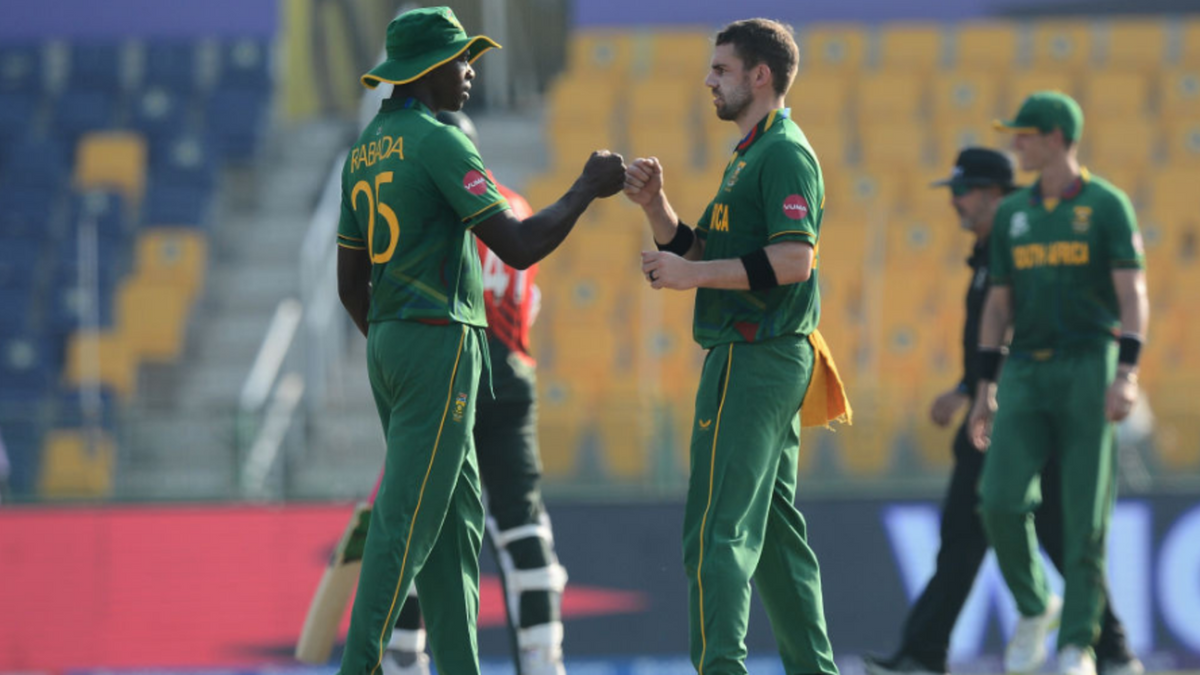
South Africa have been in fine form in T20Is of late, going unbeaten for a fourth consecutive series after a 2-2 draw away to India. It’s a result that followed three consecutive away series victories.
The recent run of success has been an emphatic statement of form following their exit from the 2021 T20 World Cup, where they failed to progress past the group stages after narrowly missing out on net run-rate to Australia. Their performances in the year since show reason for increased optimism that they could be contenders for the 2022 World Cup that’s being hosted in Australia this winter.
Here are five reasons that make them worthy contenders:
A pace attack that’s actually quick
In Kagiso Rabada and Anrich Nortje, the side is blessed with two premier T20 seamers in the world. Rabada has been a known quantity for years, having taken 99 IPL wickets at an average below 20, apart from his 51 T20I scalps. However, Nortje’s rise in recent seasons has added a second string to their world-class attack: regularly one of the fastest bowlers in world cricket, he took 18 T20I wickets at an average of 18.68 last year, with an economy below 7.
It’s hard to find an attack that has two genuine quicks working in tandem, bolstered further with Lungi Ngidi and Dwaine Pretorius in the ranks. The two, in fact, have the most wickets among South African quicks since 2019, making it a well-rounded pace attack that could blow away even the best of batting line-ups.
Wrist spin – the key to success in T20s
It’s not just pace: if you need to win in T20 cricket, wrist spin is a handy weapon to have. They’re well-stocked in the pace section, but also have the services of Tabraiz Shamsi, currently the second-highest ranked spinner in T20I cricket.
Shamsi’s record in the last year has been nothing short of exceptional, taking 27 wickets at an average of 15.22 and an economy of 6.13. His tally of 27 wickets puts him seven clear of Rabada in second place. With Keshav Maharaj for company, it’s an underrated yet crucial aspect of South Africa’s attack, and could go on to define how they fare later this year.
South Africa are the form team
In their last four series, South Africa have won away from home in the West Indies, Ireland, Sri Lanka, and drawn with India. Overall, since the start of 2019, they’ve won 17 out of their 26 games away from home. Even in the T20 World Cup last year, they had four wins from five games – and a net run-rate of +0.739 – but a tight group meant that they couldn’t go beyond.
Their ability to perform all over the world in all manner of conditions is perhaps the strongest indicator that this is a side riding a wave of performance that will place them in good stead for the World Cup.
The rise of David Miller
David Miller has been a man reinvented over the past 12 months. His form had dipped away in a number of recent IPL seasons – from 2016 to 2021, he’d crossed 200 runs in a season just once. However, a technical change this year brought about massive rewards at Gujurat Titans, the team that eventually won the IPL.
Miller enjoyed his best IPL season, scoring 481 runs at an average of almost 70, while striking at 142, a tally that towered over his 2021 returns of 124 runs at 24.80, strike-rate 109.73. Those returns are replicated in his international form too. In the last 12 months, the left-hander has averaged 39.66 for South Africa, striking at 151.27. His form, combined with the experience of three T20 World Cups, could end up being a good reason to take South Africa over the line.
The dependability of de Kock & Markram
One is a proven world-class T20 performer, whilst the other’s stock is only ever increasing. Just like the most part of his decade-long career, Quinton de Kock has remained South Africa’s leading batter over the past year, averaging exactly 40 with five half-centuries in 17 innings. The thrust at the top that he provides could be pivotal in the powerplays, an aspect where teams can really flounder in knockout tournaments.
Meanwhile, Markram has improved across the board – his off-spin continues to develop whilst he has performed excellently with his batting – his primary skill. In T20Is, he has a strike rate of 147.00 from l8 innings, and took his game to the next level in the IPL this year, averaging 47.63, and striking at 134.10.








